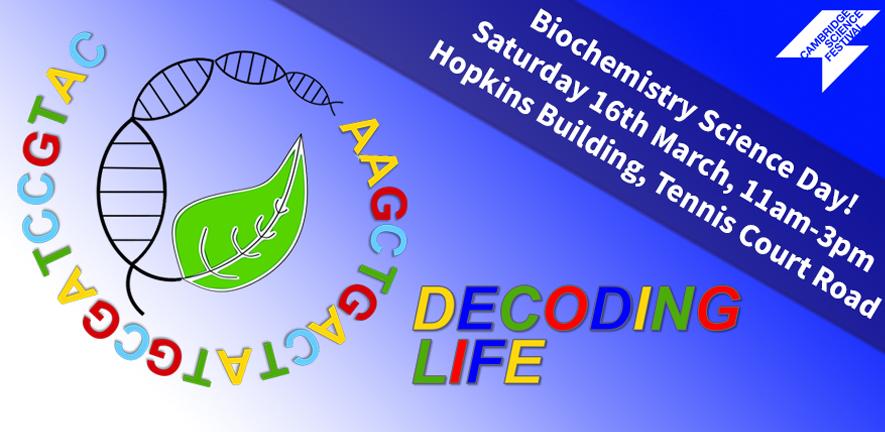
Decoding Life! Saturday 16th March, 11am-3pm.
Visit our Department and become a scientist for the day!
As part of the Cambridge Science Festival, we will be charting the molecules of life by coding DNA to protein, describing the making and purification of proteins and how they look in three dimensions, and demonstrating how drugs work and how mutations can cause them to fail. We will also be showing how proteins evolve, and how we can mimic evolution in a test tube to generate new proteins that can be used for biotechnology or for the treatment of diseases.
This free, interactive event includes hands-on experiments, informative demonstrations and plenty of fun activities for children and adults of all ages!
Hands-on experiments and demonstrations
- DNA extraction:
Isolate some DNA for yourself with this fun and easy practical! Within a few minutes you can spool a string of DNA from some fresh strawberries using every-day materials.
- DNA replication and translation bracelets:
Become an enzyme to understand how DNA replication (the production of two identical copies of a DNA strand) and translation (the production of proteins) work. Instead of using actual DNA and protein building blocks, you will be using colourful wooden beads to make DNA bracelets or protein key-rings!
- 3D macromolecules:
See macromolecules, proteins and DNA in 3D!
- Crystallography:
Find out what crystals of proteins look like, and set up your own experiments to make some sparkling protein crystals.
- Augmented reality biology:
Protein Go! View biological structures in augmented reality. Download the Augment app and use our tracking images to investigate the atomic details of some of our favourite molecules of life.
- Chromatography and other separation techniques:
Biochemists regularly separate molecules that are used in their research. This workshop will introduce you to liquid chromatography, one of the most popular methods, where you will separate green dye into its component parts.
- Solving a crime with science:
Solve a crime using paper chromatography! Using some filter paper, pens and a bit of water you'll be able to link suspects to an incriminatory message and hopefully identify the thief!
- Design a drug molecule:
Development of specific and efficient drugs is best done through understanding the interactions they make in our body. Here, you can learn about the kind of interactions you would find between drugs and their targets.
- Become a master pipetter:
Find out what it means to be precise as a scientist. Using pipettes and scales that are used daily in the labs you will get an opportunity to pipette different amounts of liquid and receive feedback on how accurate you were and on what can be improved in your technique.
- Directed evolution and micro-droplet screening - Finding new enzymes in nature:
Biochemists search the environment for useful enzymes, but this can be like finding a needle in a haystack. Come search our ball pit for rare enzymes and discover how we use microscopic droplets to find the enzymes we want.
- Directed evolution and micro-droplet screening - Testing enzyme activity:
Once you have found an interesting enzyme, you need to determine how active it is. Discover how enzymes can be used to clean the environment and how they help us break down foods.
- Directed evolution and micro-droplet screening - Making a DNA library:
No books, but lots of information: Make your own DNA library using edible treats representing all the DNA sequences in the environment.
- Directed evolution and micro-droplet screening - Making droplets:
Come look down the microscope to see big science in small droplets. Our microfluidics expert will have a live demonstration running to show how we make up to 1,000 microscopic droplets per second!
- Directed evolution and micro-droplet screening - Sorting droplets, selecting enzymes:
How quickly can you sort your library of DNA? Test your reflexes and take your sorted library away with you…
- Photography:
Strike a pose! Get your photo taken in a laboratory!
- Arts and crafts:
Come and colour in biological molecules, from DNA to proteins! You can also make 3D paper models of viruses to take home!
- DNA boxes:
Experience what it means to be a scientist! Grab a box before you leave – within you will find all that you need to build your very own DNA molecule, using the basic rules of its structure to guide you!
Social media
To keep up-to-date with all of our news for the Science Day, and to see how things are prepared behind the scenes, give us a follow on Facebook, Twitter and Instagram (@CamBiochem).
We'll be using the hashtags #BiochemDay19 and #CSF2019.
How to find us
Click here for details of how to get to the Hopkins Building. Information on the accessibility of the Department can be found here.
